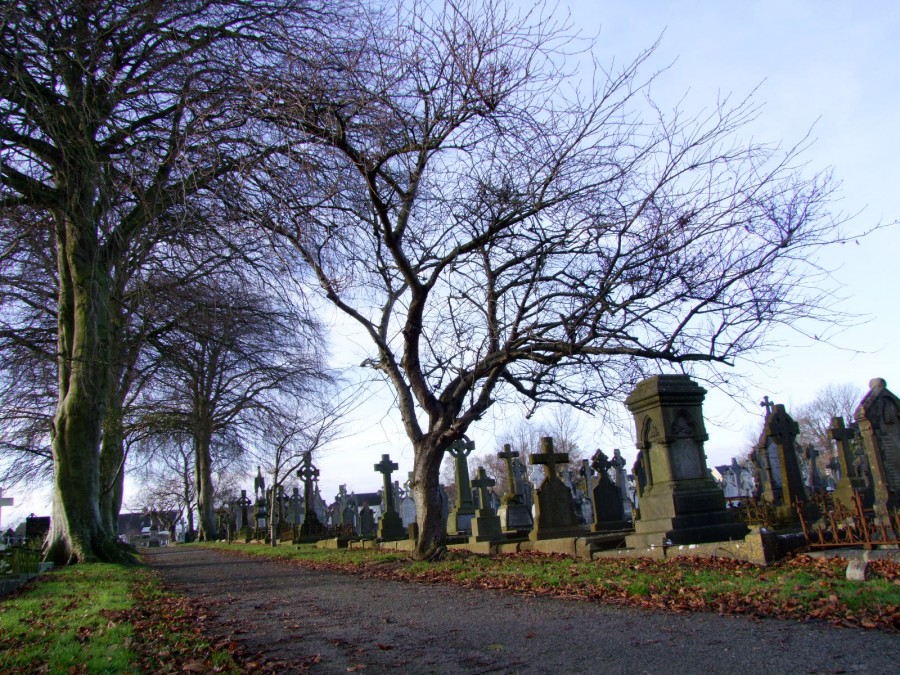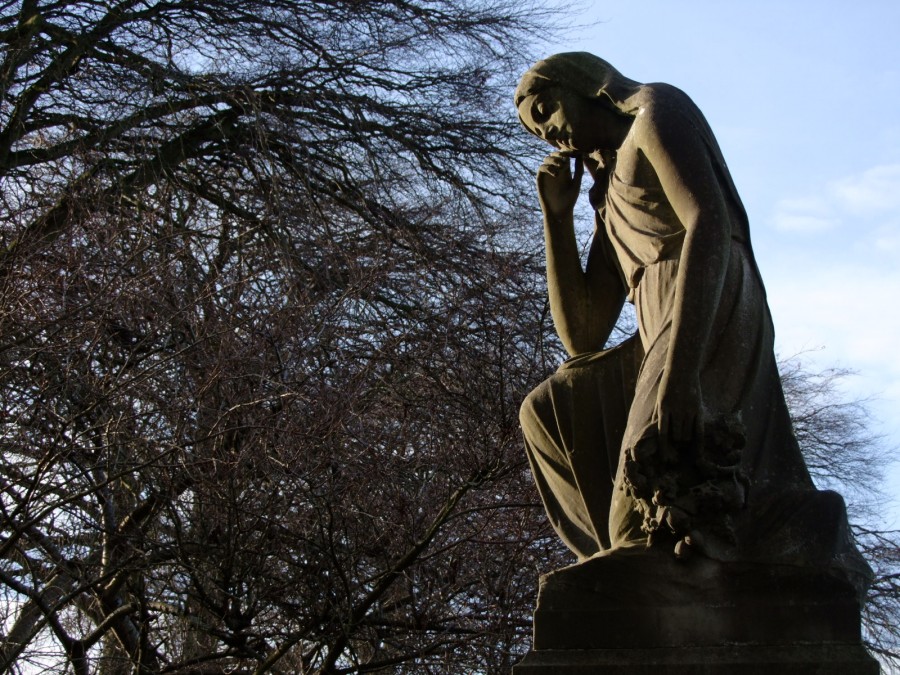
Kieran’s Our City, Our Town Article,
Cork Independent, 9 November 2017
150 Years of St Finbarr’s Cemetery
This month St Finbarr’s Cemetery in Glasheen marks its 150th anniversary of its opening for public burials. Since mid-November 1867, this beautiful cemetery has become an iconic space of reflection, art and architecture. Its back story is a long and complex one and this article attempts to shine some light on it.
The Burial Ground Act of 1856 gave great legal and financial powers to Cork Corporation for attaining cemetery ground. A growing population and limited cemetery space in graveyards such as St Joseph’s in Cork City led the Cemeteries Committee of the Corporation in late February 1863 to seek new burial ground. The Committee publicly sought in newspapers like the Cork Examiner tenders for forty acres of ground in or adjacent to the northern suburbs of the City, and a similar acreage on the south side. Sealed proposals were to be lodged on or before 28 October, to the town clerk, Alexander McCarthy, whose office was at 33 South Mall. Some ideas were received but a lack of momentum existed to pursue the matter.
Nearly seven months later, a meeting at the Mayor’s Office at no 20 South Mall on Saturday 25 May 1864 was held for the purpose of considering the defective state of burial accommodation in the City. The Mayor, Sir John Arnott in the chair, resolved that a company be formed, on the principle of limited liability, with a capital of £10,000 in 2,000 shares of £5 each, with power to increase it if it was necessary. It was decided that when the company was formed, sites should be advertised for and the most suitable should be selected for shortlisting. The committee consisted of the Mayor, Sir John Abbott, C J Cantillon, J P Booth, Thomas Jennings, Dominic O’Connor, Alderman Hegarty, Alderman Keller and M J Collins.
In late June 1864, daily advertisements by the Cork Cemeteries Company in the Cork Examiner sought twenty acres of land to purchase, to be situated within three miles of the City. Sealed proposals, stating particulars of title and cost, were to be lodged at Alexander McCarthy’s office on the South Mall. In the autumn of 1864, three sites were discussed at length in the Cork Examiner. The present site St Finbarr’s Cemetery on Glasheen Road was pitched but there was initially limited support for it within Cork Corporation. In late September 1864, Fred G Deverall, County Surveyor inspected the lands called the Commons, part of the Corporation’s lands, situated on the north side of the City, He examined the ground and found three sites, which could be made available for the purpose, one of which. contained twenty acres held by one tenant. His team dug six trial pits to ascertain the nature and depth of the soil in different places, and found an average of over seven feet of dry clay and gravel.
The third piece of ground proposed was close to Wellington Square, comprising six acres. It was not supported by those living and working within the vicinity. The Jennings estate was nearby as well as 31 inhabited cabins within a radius of 100 yards, and 55 within a distance of 200 yards. It was also in the immediate vicinity of the County Gaol and the Queen’s College. In Wellington Square there was a well or pump, which was the source of water used by the residents of the locality, and would be within twenty-three yards of the cemetery. The Professor of Geology in Queen’s College, Cork testified that the ground in some places was deficient in depth of soil.
By spring 1865, the Cork Cemeteries Company failed to get the public investment it needed and the company folded. The search for a burial ground continued for another year into early 1866. However, a sum of finance was acquired from the Westminster Treasury on favourable terms through the intervention of Cork MP John Francis Maguire.
By late November 1866, the Corporation’s cemetery committee and the Corporation selected 15 acres of flat and rectangular ground at Glasheen. The cost would be £600 to the occupying lease-holder and £125 to the tenant who was growing crops on the site. The Cemetery Committee prepared to receive proposals for building a boundary wall, to enclose the land taken by the Corporation for the cemetery. The ground combined the various qualities required for a cemetery as the soil was dry, sandy and deep. A plan of the intended cemetery was prepared by Sir John Benson, the city engineer. The ground was to be laid out much on the plan of Glasnevin in Dublin, and planted with ornamental shrubs, and divided by walks.
A fourth of the entire new cemetery space was to be allotted for the burials of persons of the poorer classes who would not be able to pay the charge to be made for interments. Two thirds of the cemetery were to be reserved for Roman Catholics and one third for Protestants. Each religion was to have a mortuary chapel for its separate use. By mid-January 1867, the Cemetery Committee sought tenders from competent parties for the erection of two chapels on the grounds of the new cemetery. In late April 1867, the Committee sought proposals from competent parties for the building of a registry office at the entrance to the cemetery.
Captions:
920a. St Finbarr’s Cemetery, present day (picture: Kieran McCarthy)
920b. Ornate statue, St Finbarr’s Cemetery, present day (picture: Kieran McCarthy)

Ready for Expansion
Thanks Lord Mayor; the annual budget evening for me offers lenses to see where the Council is progressing.
It is important to note that 2009 coincided with an expenditure of e.200,427,800 whereas today its e.160,241,400. And that drop in support for Ireland’s southern capital needs to be consistently highlighted.
In a year where the debate rages on the city pursuing an expansion, I would like to thank our twitter team during the week for drawing out some big picture positives on how much is spent per citizens on a multitude of services.
I am glad that we remain championing competing demands across the city’s social, economic, cultural, environmental and infrastructural development.
It is important that the Council does not become a one trick pony. Too often this Council is pulled into silo-ised debates on housing and roads. It is true to say they are very important but only make up about 45 per cent of the total budget. An increased homelessness budget is welcome but does show the increased homelessness challenge. I don’t want to welcome an increased budget for homelessness, I want the issue addressed and that there should be no need for a budget line on homelessness.
Need for Holistic Vision:
We need to retain a holistic vision for this city. Cork has such great gorgeous public spaces and we should never forget to call to mind our urban space and to celebrate our historic urbanism. The 500 trees recently blown down need to replanted; our parks and graveyards need to be maintained. I see next week St Finbarr’s Cemetery is celebrating its 150th birthday since its opening and its story is one of the Corporation of Cork seeking to expand its service but in 1860s Cork.
And I note with joy that funding for the 180 acres Tramore Valley Park has been allocated. This will be as the CE notes in her introduction as a “tremendous facility”, but it is also a serious advancement of the city’s investment in all things green, in renewable energy from beneath the park in the decaying landfill, in family life, in community life, in our parks development, in our Healthy Cities programme, in thinking in creating a series of regional park, and engaging all of the citizens in it.
We also have aspects such as the Local Economic and Community Development plan, which I would like to unpack and move forward with plus I think there should be more focus on showcasing the Local Economic Development Fund and getting more and more visibility to the many entrepreneurs, start-up and SMEs in the city. Streets such as the South Mall should be fully re-imagined as start-up street.
Interestingly from the outside looking in, the city is known for education and learning and its creativity and culture. Education and culture matters in this city as do many other aspects.
These concepts were also borne out as well with the UNESCO conference. We need to celebrate this city’s drive and ambition more. Yes, there are challenges but there are also multiple layers of success stories.
Being pro-active and not reactionary:
I think the future when the expansion takes place into the County will require experience of multiple strands of imagination, and pro-active pursuit of challenges to meet in an enlarged city. To be stuck in the gear stick of reactionary local government instead of a pro-active one does not help this Council or any other one.
Ongoing toolkit:
So I would like to think this budget is an ongoing toolkit of sorts on what the priorities in an enlarged city will lie. Many are positive investments. And in a week where this Council and the County Council made joint submissions on the draft National Planning Framework a core message must be to give local authorities access to further funding streams. And I don’t think the game is with increasing the Local Property Tax here – our Council require millions of euros to advance any national urban agendas.
And as before we gained large scale funding from European Structural Funds – because of our re-territorial classification as a much improving state, any of the new infrastructure coming online such as the Merchants Quay Bridge and Marina Park come from small EU urban agenda grants.
It is difficult to raise locally the funding required for large scale infrastructure and once again I call for a second EU officer who is tasked to track down future funding schemes.
I am very proud of some of the finished capital projects this year such as Blackrock Pier Regeneration project or the methodology adopted by our housing officers to accumulate near e.100m to pursue inner city renewal social housing projects. I think giving senior officers time to think through future funding avenues is highly important.
And we need to acknowledge v talented staff to bring such work forward.
Thanks Lord Mayor.

